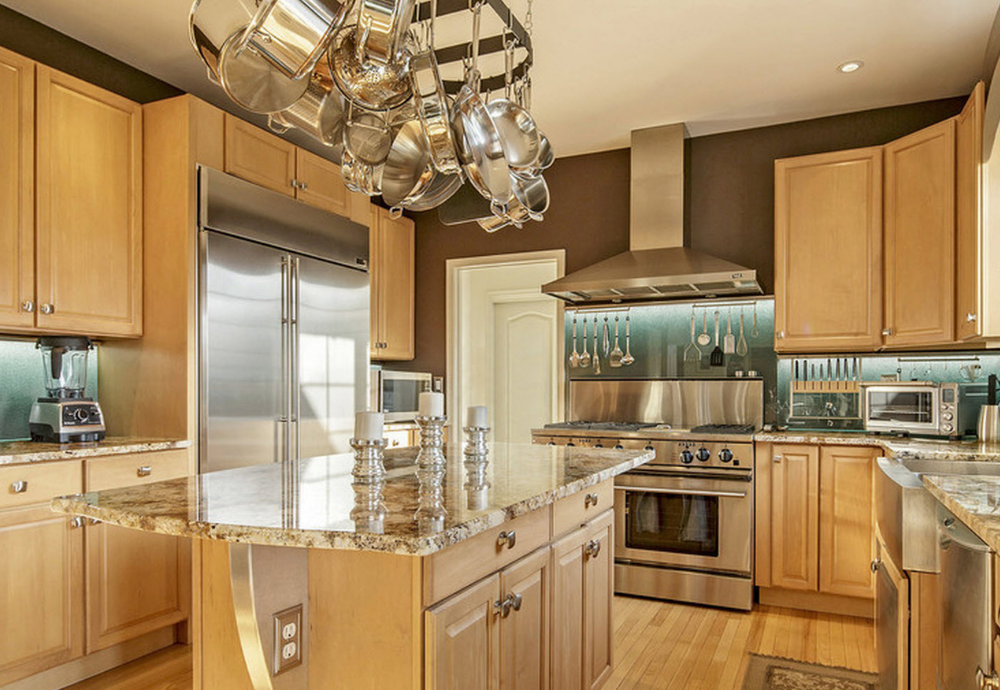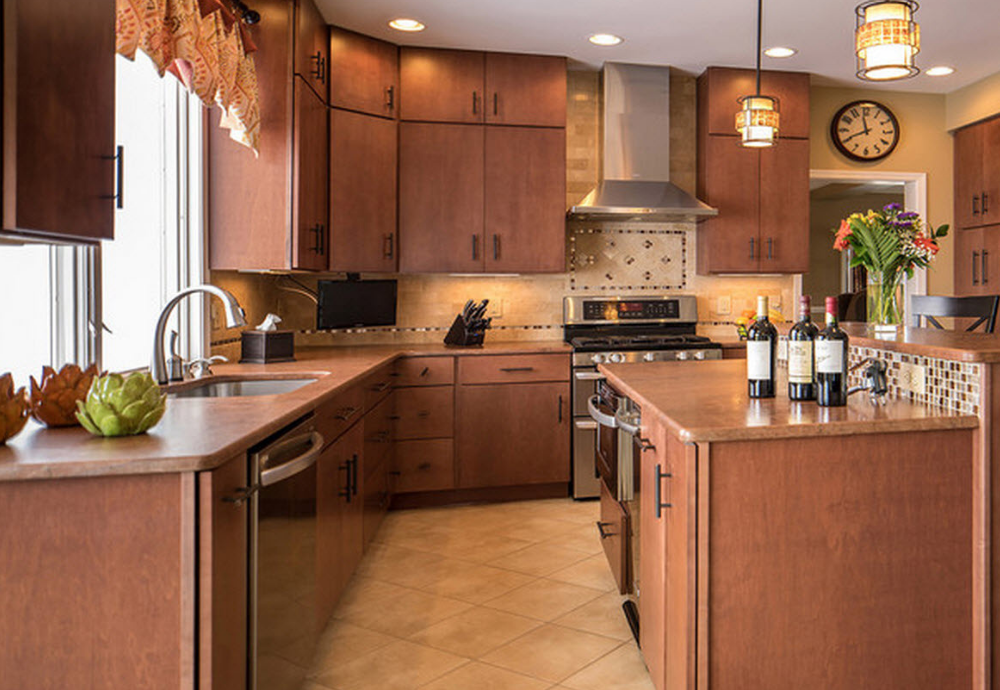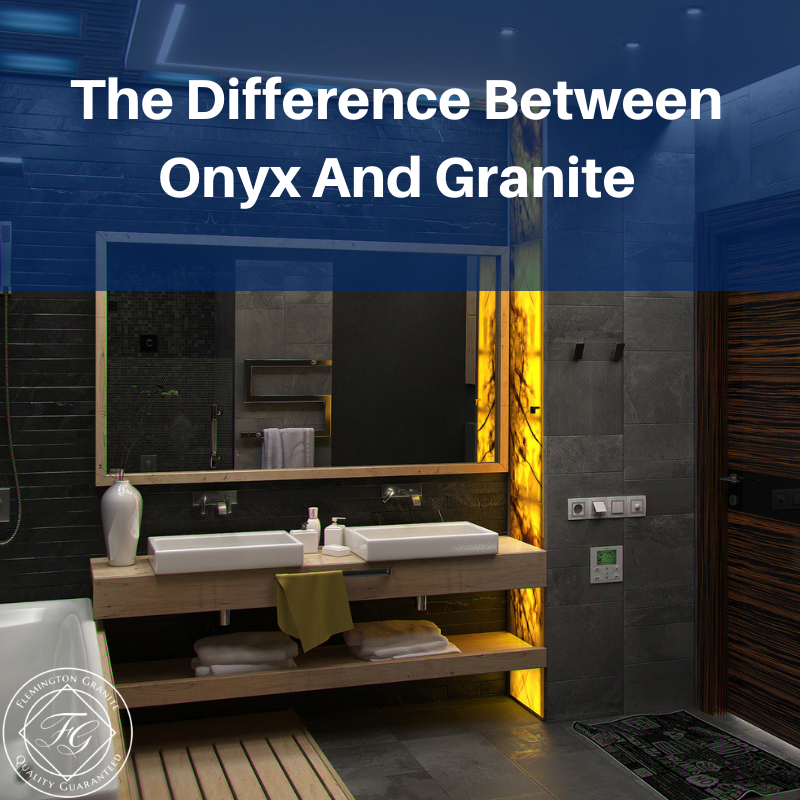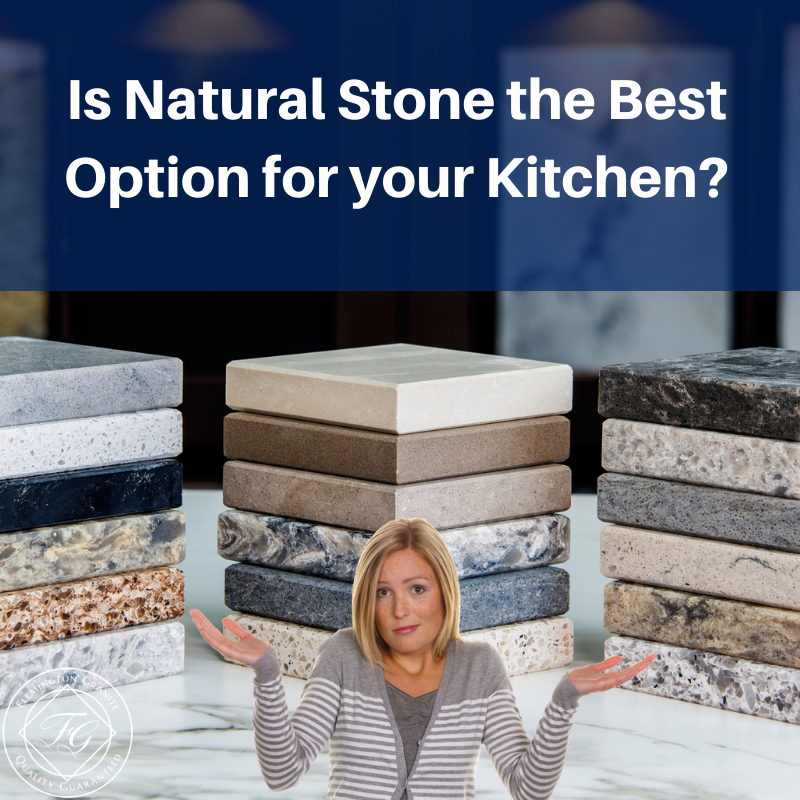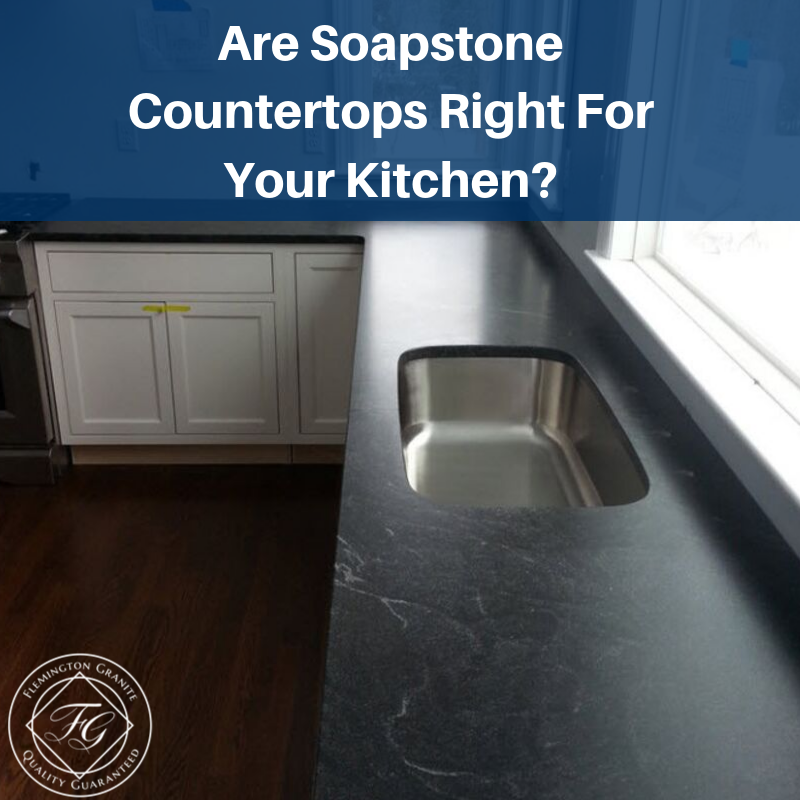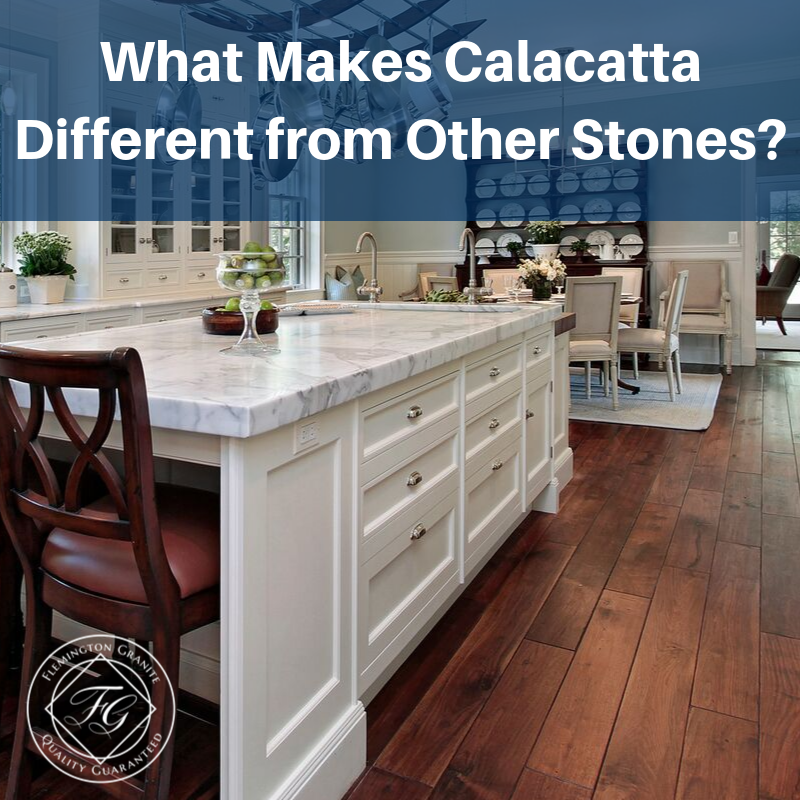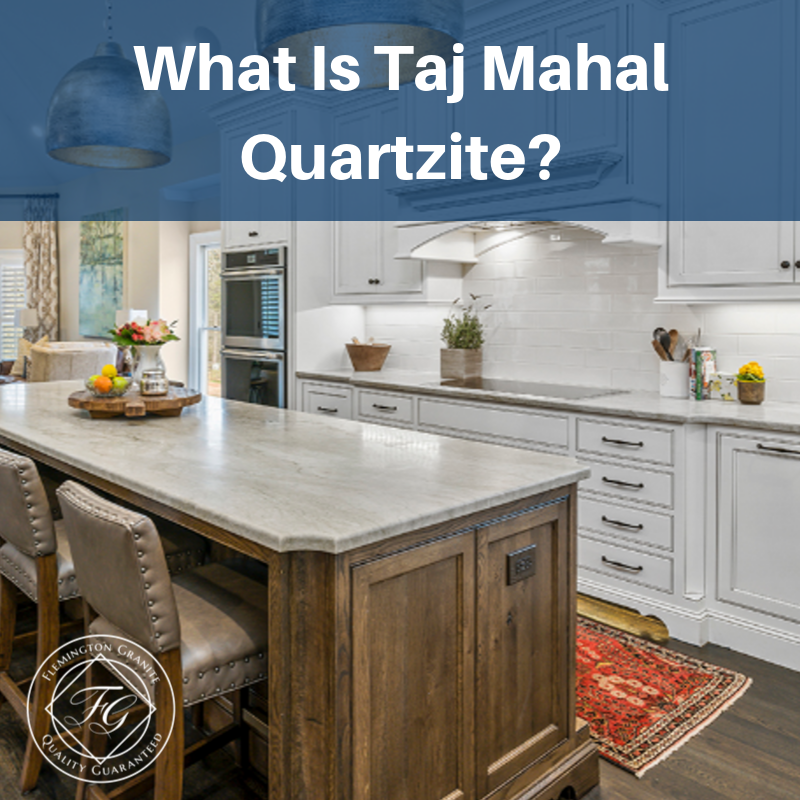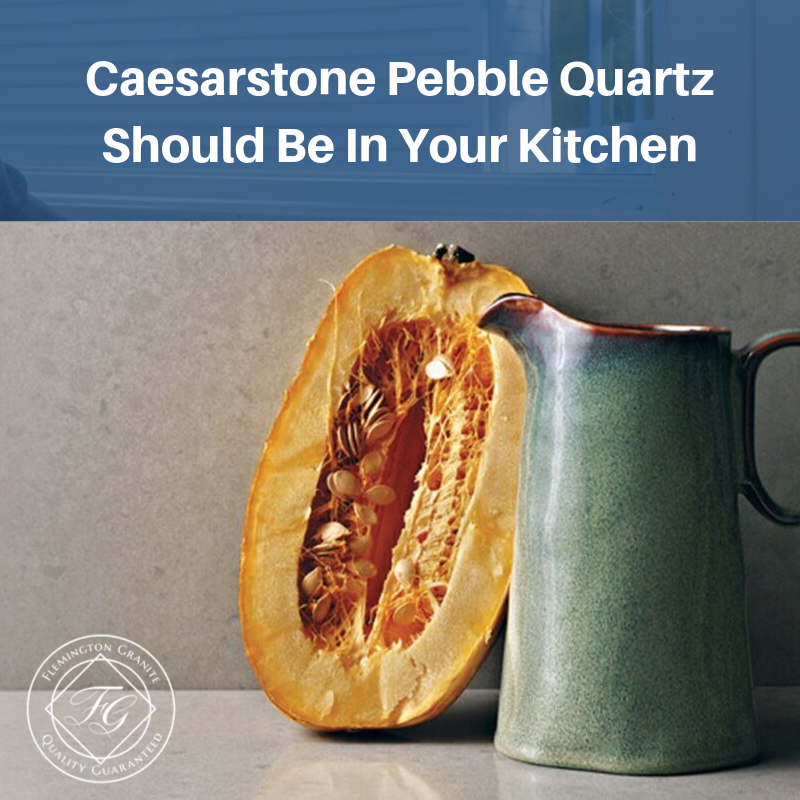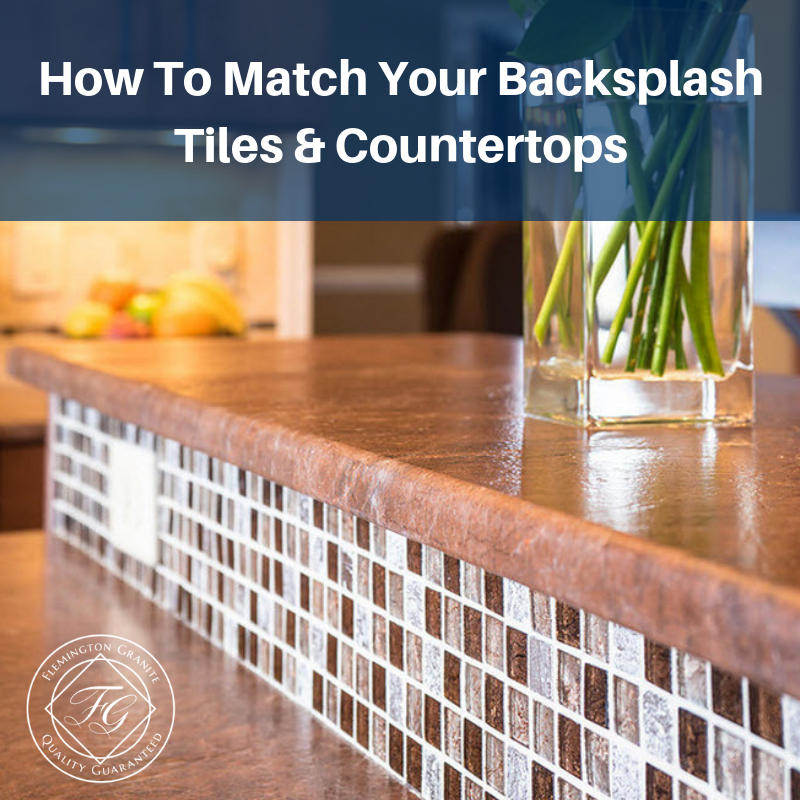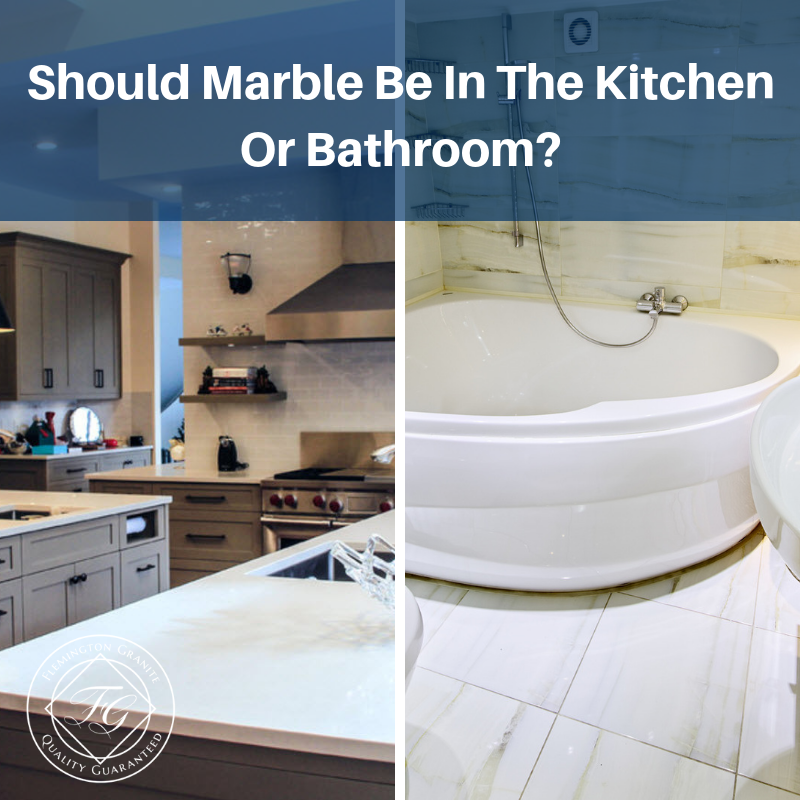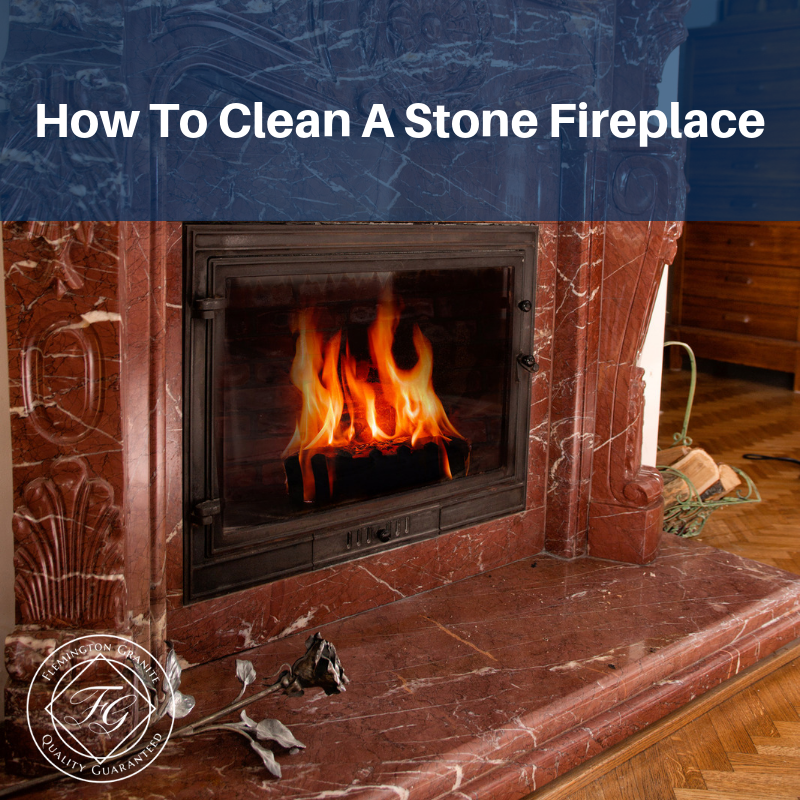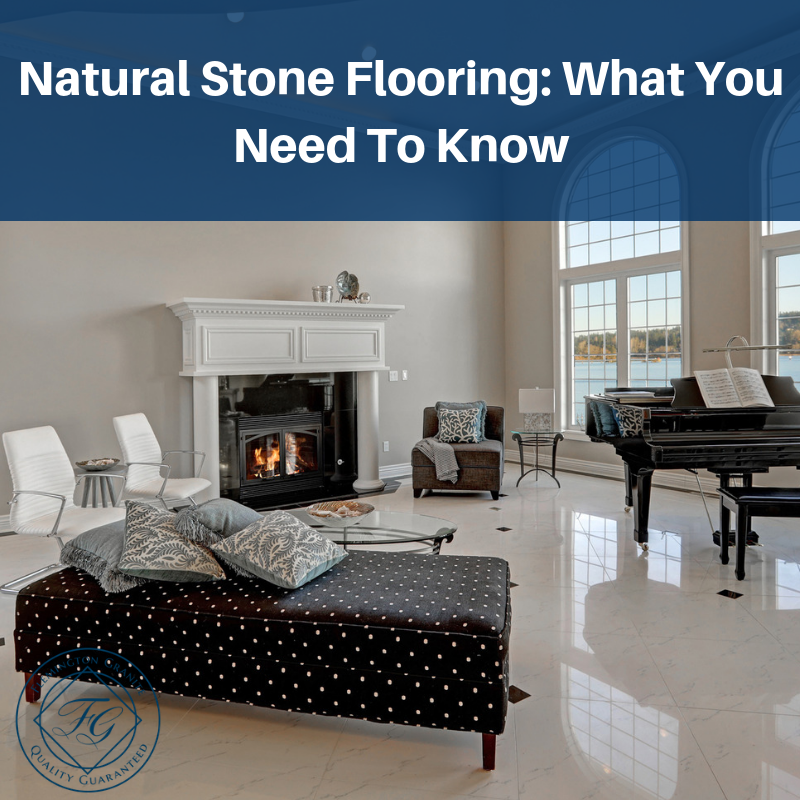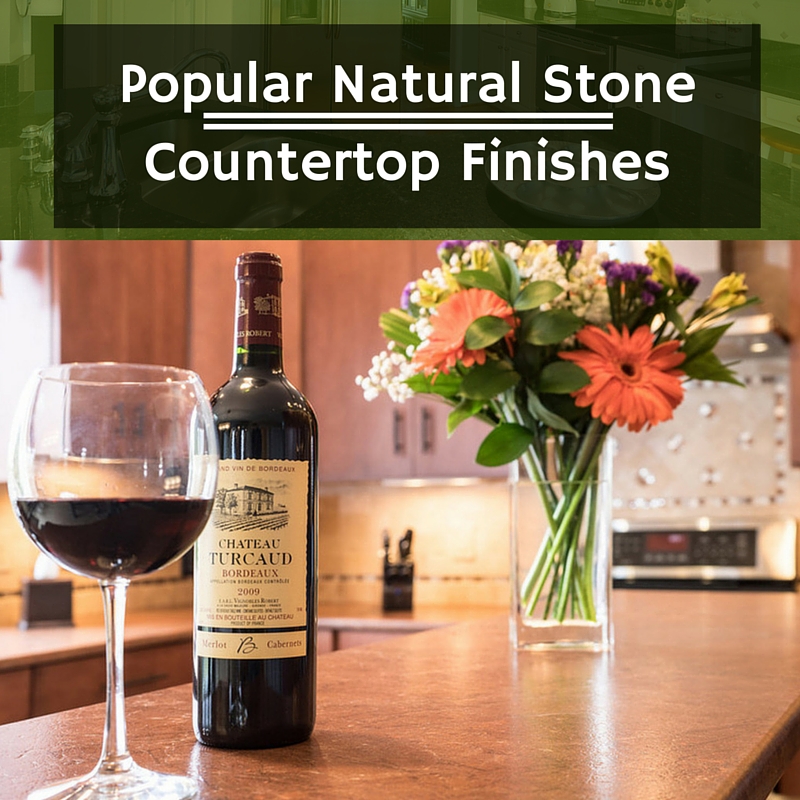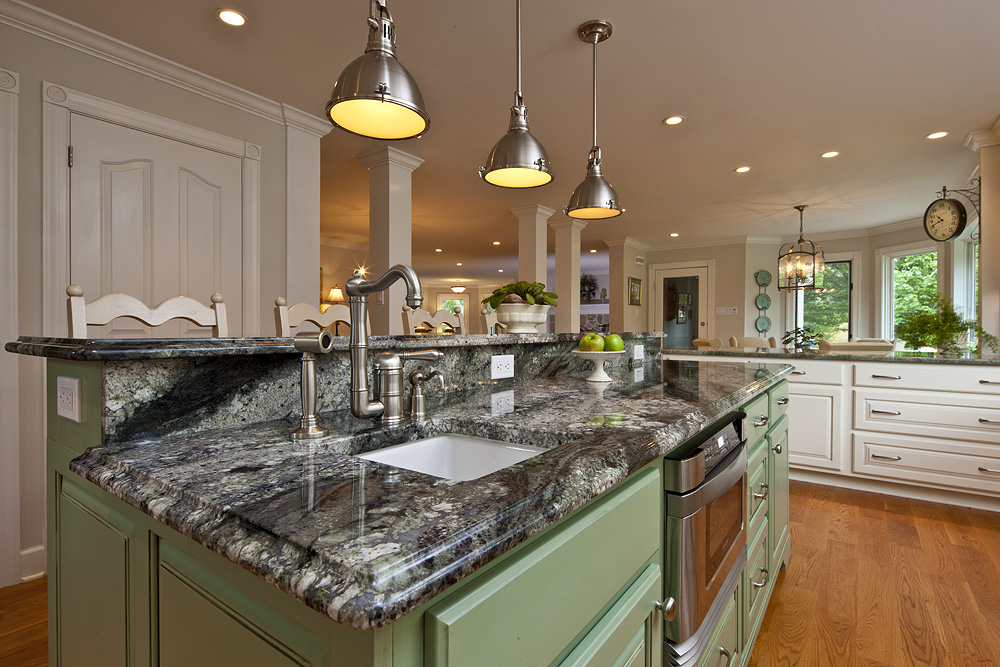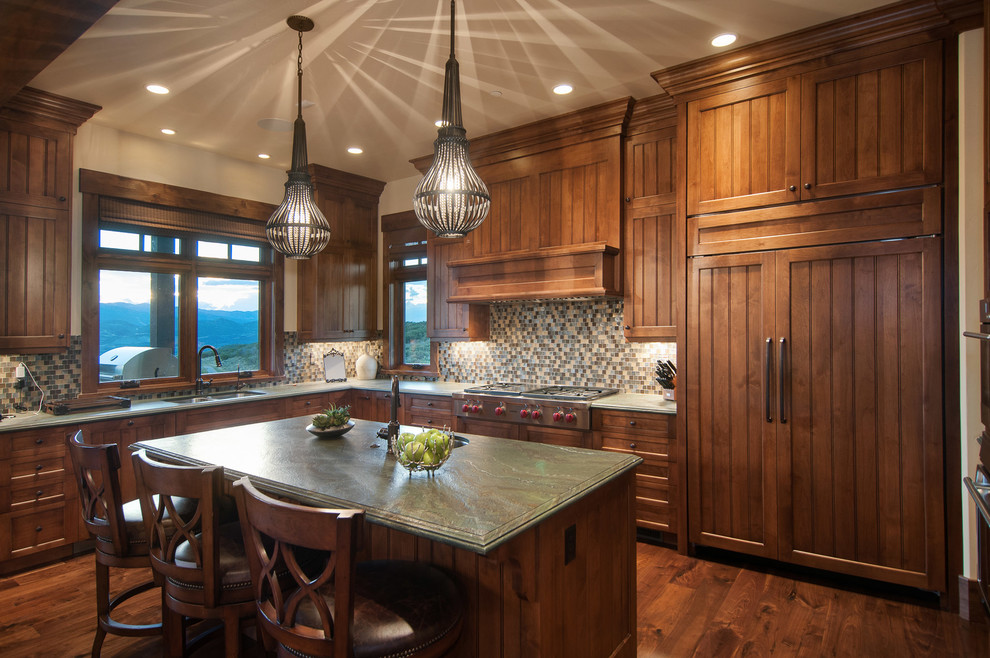Natural stone not only has beauty but it carries lots of options and benefits that are conducive to most styles and designs used in kitchens today. Renovation or remodeling projects can be easily upgraded and enhanced with most any natural stone selection. You can’t go wrong with a natural stone choice as it’s not only an enduring material but it’s one that provides a lasting and redeeming value to any home. So, just what are some of the many benefits that the use of natural stone can bring to a kitchen remodel?
The Pros & Cons of Natural Stone Countertops
Modern technology has given us more options than ever when it comes to choosing a new kitchen countertop. There are too many options to name, and that’s fine because we are only talking about one of those options today. Natural stone is probably the most deluxe and expensive option that you have, but it offers some unique advantages that even synthetic stone cannot fully match. Let’s take a look at the pros and cons of natural stone countertops.
The Pros:
Let’s take a look at the upsides of natural stone.
Beauty
View this post on Instagram
Nothing can match the beauty of a natural stone surface. The huge variety of colors and patterns that we see in these natural materials is second to none, and that’s the main reason that people pay large amounts of money for countertops made of granite, marble, and others. When you buy a piece of natural stone, you know that you are buying something unique. While many other stones might be similar, no two will be alike.
Smoothness
Natural stones provide a completely smooth surface, which is very good for food preparation. Wooden surfaces work fairly well for food preparation, but there is just one problem: Wood has a grain, and the tiny gaps in the woodgrain will often catch liquids, dough, and other refuse material. Of course, you can sand and seal your wood, but there will still be gaps unless the whole thing is one solid piece.
Bakers particularly like stone countertops because of the nice uniform smoothness that they get from their surfaces. To be fair, though, you have to choose the right kind of stone if you want to enjoy this benefit. Some stones, like soapstone, are porous, and that means they have to be treated with a sealer. Even some forms of granite are semi-porous, so watch out for that.
Heat Resistance
Nothing can resist heat quite like natural stone. When you set a hot pot or skillet on a stone countertop, you can be pretty sure that it won’t burn. Try that with a wooden countertop, and you will quickly find yourself with black rings on all the surfaces of your kitchen. Many artificial materials claim to be fireproof but are only mostly so. Such countertops are more fire-safe than most, but they won’t absorb and dissipate heat in the way that stone can do.
Durability
We have listed durability as both a pro and a con, and there is a good reason for this. You see, natural stone is very durable in some ways but not so durable in other ways. By the time we are done, you will understand what we mean.
First of all, we have already mentioned the heat resistance of natural stone. We should also mention how well natural stone can resist scratching and scuffing. While no material is invincible, it takes some serious effort to scratch most stones. A person would almost have to be doing it deliberately.
When it comes to resisting chemicals, natural stone also tends to do quite well. In fact, it is common for laboratories to use stone countertops because of the fact that they don’t react with many things. Thus, there is less interference when these scientists are performing various chemical reactions. As long as you don’t pick a soft stone, your countertop should be able to resist any chemical short of concentrated acid.
The Cons:
Let’s take a look at the downside of natural stone.
View this post on Instagram
Cost
As you may already know, natural stone countertops are quite expensive. We have already covered price ranges in some of our previous articles, so there is no need to repeat the information. Suffice it to say that few materials are as expensive as natural stone. To be honest, some of this factor will depend on which kind of stone you choose.
If you cannot afford high-quality premium natural stone, then we recommend that you purchase a relatively low-grade stone and use a sealer product. Most sealer products are inexpensive and easy to use, so there’s no excuse not to use them. Those who are on a budget might find this a great way to get the stone they want at a more realistic price.
Weight
This little disadvantage shouldn’t come as a surprise to anyone. Natural stone is very heavy, and the more durable types (like granite) tend to be the heaviest. As such, you had better make sure that your cabinets are strong enough to hold all that weight!
You should definitely consult with a home improvement professional before installing stone countertops, just to make sure that you won’t cause a catastrophic collapse. If your cabinets are not strong enough, it might be possible to reinforce them with extra pieces of wood or metal.
Often requires sealing
In the majority of cases, natural stone will require sealing. This isn’t a huge problem, as sealer products aren’t that expensive, but it makes for a little bit of confusion when buying stone. It is very hard to know which stones will need sealing and which ones will not. For instance, some granite requires sealing, while other granite types do not. Thus, there is a little guesswork involved here, and that’s never a good thing.
Durability
As we mentioned earlier, durability is both a pro and a con for natural stone. Though they do a great job of resisting heat, chemicals, and scratching, they don’t do so well with impact resistance. One sharp blow can be all it takes to crack a natural stone countertop right down the middle. These stones are tough, but they don’t resist impact very well.
Conclusion
Natural stone is an option that many people cannot afford, and yet, we would probably all be using this material if we could. Even when you consider the high price and the low impact resistance, you still have to consider all the upsides and realize that natural stone countertops are a great option for those who can afford them. If you have found this article to be helpful and educational, please fill out the contact form below.
The Difference Between Onyx And Granite
When you are renovating your kitchen or bathroom or home bar, one of the best things you could do for the overall look and feel is to install a natural stone countertop. People commonly think of granite for their homes, but there are other options that are just as, if not more, beautiful. Onyx, for instance, is a competitor for stone countertops and looks incredible anywhere it is placed.
But which option is right for your home? Let’s put granite and onyx head to head and find out.
Overview: Granite vs. Onyx
When it comes to figuring out the best stone for your home, it’s all about knowing the specifics. Here are the details about each kind:
Granite
Granite is dense, coarse igneous rock that is comprised of mica, quartz, orthoclase, and microciine. The mica is what gives granite its glimmer.
Cooks love granite because of how resilient the stone is to damage in the kitchen. Hot pots and pans, as well as knives, will not damage granite countertops as quickly as other types. This durability has made granite a popular choice in households for many years, and now you can find granite in hotels, luxury homes and condominiums, and even in commercial buildings.
Onyx
People assume onyx is always black, like obsidian, but that’s not always the case. Onyx is actually a variant of marble that also contains calcite. This gives onyx a translucent quality that homeowners can play up with lighting.
Onyx is a natural stone but also rare, so it is usually available in smaller slabs. It is also more fragile than granite and cannot endure as much stress.
Look of Granite vs. Onyx
Although both stones come in a variety of colors, only one might have the look you’ve been searching for.
Granite
The colors granite can come in are vast. Sometimes granite is one single shade or a swirl of hundreds of colors. You might see blacks, reds, blues, greens, and much more. Some stone is flecked while others have large veins of color. Granite differs from piece to piece, but some stones are not as wild looking as others.
Onyx
Onyx is light and can be translucent, so under-counter lighting is always an option for showing off its beauty. Onyx can range in multiple shades, such as pinks and golds, reds, blues and greens. Since onyx is variable, some pieces might be solid colors while others are streaked or flecked.
Care Instructions for Granite and Onyx
Let’s look at the differences in upkeep between these two stones.
Granite
You should always use stone cleaners on granite and sealant to stop any staining. Granite is rather dense, so you may not need sealant. Also, granite is strong enough to withstand strong impacts, knife blades, and even direct heat from pots and pans—but you should not subject the granite to this all the time, as it can break.
Never let acids or vinegar sit on granite for an extended period of time, as it will weaken the stone. Clean up spills as soon as possible.
Onyx
Unlike granite, onyx is not resistant to heat and blunt force. It will mark up with acids and can also be stained by cleaners. Therefore, onyx is best placed in locations with low traffic. Any liquids should be wiped up quickly, since the stone may stain.
Onyx needs to be cleaned with stone cleaner often and be sealed up regularly to avoid discoloration.
Cost Analysis
Sometimes, the deciding factor is price. Neither are cheap, but one might be a better investment than the other. Please keep in mind that the prices listed are estimates and do not reflect all contractors.
Granite
Depending on the kind of granite you select, you will potentially pay anywhere between $80 to $175 per square foot (give or take). Some companies may charge additional installation feeds or extras for certain types of edging, so consider that as well.
Onyx
Because onyx is rare, you may have to spend upwards of $250 per square foot. Plus, the pieces are much smaller than granite. Don’t be fooled by pieces that are $40. It will not be as high quality as more expensive pieces.
Granite vs. Onyx: Which Should You Choose?
Both countertops have their advantages and disadvantages. Choose wisely! Do you want something more affordable and resistant to damage? Or do you want an exotic piece that becomes the center of attention in your home?
Granite countertops are the correct choice if you want functionality, while onyx can be a breathtaking highlight in kitchens, bathrooms, and bars.
Still having trouble deciding which stone is right for you? Or do you have a renovation project in mind? Fill out the contact form to get in touch with us! We’re more than happy to answer your questions or send you a quote.
Is Natural Stone the Best Option for your Kitchen?
When it comes time to remodel your kitchen or if you are building a new home, deciding the right countertops for your family can be difficult. Today, natural stone is one of the most popular types of counter materials yet even deciding which type of stone can be difficult. These advantages and disadvantages of natural stone as well as descriptions of the various types of stone countertops you can get, can help you make a better informed decision.
Resale Value
One of the biggest advantages to natural stone countertops is the luxurious look it gives your kitchen. When it comes time to sell your home, natural stone will be attractive to buyers due to its durability and minimal maintenance. Even if you don’t plan to sell your home soon, you want to create a kitchen that buyers will fall in love with so that when it is time to sell, you not only recover your investment but sell your home more quickly as well.
Durability and Food Prep Safety
When maintained properly, natural stone counters such as granite or quartz may actually last longer than any other feature in your home. Stone outlasts solid surface, laminate, tile and butcher block, retaining its beauty with very little maintenance. In addition, natural stone can handle even the busiest kitchen without looking worn or damaged. Most natural stones are heat and scratch resistant, unlike solid surface, butcher block or laminate. Because most natural stones are non-porous, they are highly sanitary as bacteria cannot accumulate in the surface. Even stones that are more porous than others, like marble, can resist bacteria if it is sealed properly and the seal is maintained. In addition, if you enjoy baking, marble is the perfect choice as the coolness of the stone works well with pastry.
Low Maintenance
Natural stones are very easy to maintain, requiring only mild soap and water for cleaning. There are some types of stone that require sealing, such as marble and soapstone. The sealant needs to be reapplied every few years. This is not a difficult task and it is possible you can apply the sealant yourself. There are special stone cleaners available that you apply periodically and buff until dry to keep your granite looking brand new. Although stone counters are difficult to scratch, it is important to always use cutting boards as the stone can actually damage your knives.
Granite Countertops
When deciding which stone to use for your counters, it is important to understand what some of the disadvantages of each stone may be. Granite, by far the most popular kitchen counter material, is extremely hard and difficult to scratch. It is porous, however, so it does need to be sealed periodically. If the seal is compromised, some foods could stain your counter. Granite is also only available in colors that can be created by nature and every slab of granite is different. If you have a large counter area, this could mean counters have different veining depending on how you stand in the room.
Quartz Countertops
Another countertop material that is growing in popularity are quartz counters. These are engineered stone countertops created from crushed quartz mixed with coloring and resins to create an extremely hard surface. Because it is engineered, it is available in a wide range of colors. Quartz does not need sealing like other types of natural stone. However, because the stone is mixed with resins, it is not as heat resistant. It is recommended that you always use hot pads and trivets to protect the surface. Many homeowners choose quartz over marble or granite because the stone has a warmer feel than other types of stone.
Marble Countertops
Marble has been used as a building material for centuries. It has a cooler feel than other types of stone which is why it is the perfect surface to work pastry. However, marble is a much softer stone than quartz or granite so it is susceptible to scratching and staining. Red wine, coffee, juices and citrus can damage the counter so spills need to be wiped quickly. Marble also needs to be sealed regularly as well.
Family Lifestyle
One thing to consider when choosing natural stone countertops is how the stone will work with your family. If you have a busy family, granite may be the best option due to its versatility and durability. Choosing a darker granite counter will also help hid stains and small scratches. If you have small children but really love the look of marble, you can find quartz counters that mimic that look but don’t have the staining or scratching issues that marble may have.
Choosing a Finish
Once you have selected the stone that will work best for your family, you will have to choose a finish. Polished stone requires the least maintenance and keeps its beauty the longest. Honed or brushed finishes can be difficult to maintain, especially if you are a busy cook. Some homeowners like the changes that occur in honed or brushed counters over time, thinking that the slight changes make the counters more unique.
Ask to See Individual Slabs
Keep in mind that, other than quartz, which is engineered, each natural stone slab will be different. You can ask to view several different slabs to get a feel for what will work best in your kitchen. A good installer will be able to place the slabs so the veining works well together. By having you look at individual slabs, the fabricator will get an idea what you are looking for when it is time to install.
If you are considering natural stone for your kitchen, contact us today to learn more. Our helpful customer service staff will walk you through the process so you know what to expect every step of the way. With decades of experience, we can create a kitchen that you will love for many years to come. Schedule an appointment today by filling out the easy online form or giving us a call.
Are Soapstone Countertops Right For Your Kitchen?
Stone countertops are an elegant and stylish way to accent your home with the beauty of nature. In most cases, a slab of polished stone looks much better than a slab of wood. More importantly, it will probably last much longer. But that still leaves us with one question: Which kind of stone to use?
Today, we will be taking a look at soapstone, which is one of the more popular choices. Our purpose is to help you determine if this kind of stone is right for your home. We will do this by evaluating the stone based on a set of important factors.
Factor 1: Price
Most of the time, soapstone tends to be cheaper than other stones like marble or granite. There are several reasons for its reduced cost, but most of it probably comes down to availability and convenience. Soapstone is very common throughout the world, much like granite. Unlike granite, it is fairly easy to cut and shape. This makes the mining process easier and cuts down the price.
But how much of a difference are we talking here? Let’s make a quick price comparison. We can search for prices on stone slabs, which will give us a good idea of the price per square foot. So, let’s compare marble, granite, and soapstone.
Here is a marble countertop that measures about 1×6 feet. Its cost is about $170. That comes out to $28 per square foot. Here is a granite countertop that measures about 2×9 feet and costs $485. That equals about $27 per square foot. Finally, here is a site that sells soapstone countertops for $14.00 per square foot. Thus, we can see that soapstone is about half the cost of granite or marble.
Factor 2: Durability
When it comes to durability, soapstone is a double-edged sword. On the one hand, soapstone does a much better job of resisting moisture, staining, and heat damage. On the other hand, soapstone is much more vulnerable to scratching and chipping. All of these qualities come down to the properties of the stone itself.
Soapstone is a non-porous stone, which means that it presents a completely smooth surface. Liquids cannot penetrate the surface because there is simply nowhere for them to go. Granite, marble, and many other types of stone are porous, which is why they absorb moisture and stain. This is why those types of stone require a good sealer product to obtain maximum longevity. Soapstone doesn’t have that problem.
However, soapstone is a relatively soft stone. The hardness of all substances is measured on the Mohs scale, and soapstone ranges between 0 and 1. Soapstones that are used in countertops will usually be on the high end of that spectrum, but that is still a very soft stone.
Because of this, you will need to be careful not to use your soapstone counter as a cutting board. Get a separate cutting board, as steel will quickly scratch and gouge a piece of soapstone. In fact, it’s good to keep sharp objects off the stone as much as possible. You should also be careful not to slam heavy objects on a soapstone counter, as this can also break them. Thankfully, it is often possible to repair a damaged soapstone slab with epoxy or other methods. Also, soapstone is very easy to sand, which makes it easier to sand away those ugly little scratches.
Factor 3: Appearance
When it comes to beauty, soapstone can hang with the top contenders. Like granite and marble, soapstone comes in a huge variety of patterns and colors, although black and grey are the most common colors. Different types of soapstone are found in different localities. For instance, take a look at Gala Red soapstone, which is one of the most beautiful varieties.
For some people, the relatively small color palette of soapstone could be a problem. Most soapstone is not brightly-colored, so it may not go with your decor if bright colors are what you prefer. Still, dark colors tend to go with anything. Surprisingly, soapstone will actually change color over time. As soon as you pull this stone from the ground, it begins to oxidize much like iron or steel. This normally causes a darkening of the stone that some people really find attractive.
Factor 4: Maintenance
Soapstone requires far less maintenance than most other stone countertops. While granite and marble require sealing, soapstone does not. We have already mentioned the non-porous nature of this stone, which means that you don’t need to spend money on a sealer. Since most sealers have to be re-applied, that also cuts down on maintenance.
The short version of the story is that soapstone requires no maintenance whatsoever. It might require repair if damaged, but that isn’t the same thing. There is only one maintenance process that you will ever want to do on this kind of stone, and it is an optional one. If you want to accelerate the natural darkening of the stone, you can rub it down with mineral oil or wax to darken the surface.
Conclusion
Overall, soapstone has quite a few benefits. It doesn’t stain, and it is immune to water, chemical, and heat damage, and requires no maintenance. Not only that, but it tends to be a lot cheaper and is just as beautiful as any stone on the market. However, it doesn’t hold up well to hard use. Knives, heavy cooking pots, and other steel implements can really do a number on this kind of countertop if you aren’t careful.
Overall, we advise you to base your decision on your kitchen habits. If you like to move fast and throw things around, this might not be the right kind of countertop for you. If you are one of those “slow and steady” types, the lack of durability should present no real problem. We hope that you have enjoyed this article and that we have given you all the information that you need and more. If this is the case, please fill out the contact form below to receive more crucial information like this.
What Makes Calacatta Different from Other Stones?
Marble countertops have grown in popularity over the past decade, creating rooms that make a statement. Marble sends a message of luxury and sophistication, but with so many options to choose from, you may be confused about what is the best option. You may even wonder why a marble countertop is a better choice than other types of natural stone. Understanding marble, especially calacatta marble, and knowing its advantages and disadvantages can help you choose the perfect stone for your kitchen.
About Calacata Marble
When you are looking at some types of countertops, like Corian, Silestone or Caesarstone, a sample gives you an idea of what your counter will look like once it is installed. It is much more difficult with marble, however, as every slab of marble is different. Nature creates a wide range of patterns and colors so veining in one slab of marble could look completely different in another slab, even if they are quarried at exactly the same time. Marble is quarried in many different parts of the world but the marble found in Carrara, a town in northern Italy, is one of the most readily available in the United States. Italian marble is found in three different types which include Calacatta, Carrara and Satuary.
Differences from Other Types of Marble
The first thing you need to do is to compare the three types of Italian marble to decide what will work best for you. Carrara marble is the most commonly found in this country. It has a gray background, or field as experts call it, with light gray veining. Often, the stone leans toward blue-gray and the veins are soft and feathery. Statuary, also quarried in Carrara, has a bright white background with little color variation. Veins are normally dark gray, giving the stone a distinct contrast between light and dark. Calacatta also has a bright white background but it offers a wider range of vein coloring. The veins in Calacatta are thick and dramatic, ranging in color from golds, browns, beige and dark gray.
Pricing Differences
Carrara is normally less expensive than the other types of marble quarried there. The average cost is $75 to $100 per square foot and it is plentiful. Calacatta and Statuary are much rarer and the supply is not as plentiful as Carrara so the cost is higher. There are slabs that cost as much as $250 per square foot. It is important to remember that costs vary by supplier as some are considered exclusive so they will charge more. They may also have more distinctive marbles to offer than the big box outlets who offer fewer options. Thickness also has an impact on how much marble costs. Countertops are cut to one or two centimeter thickness with one centimeter the most popular option as it is much less heavy to install.
Maintenance of Marble
The three stones require the same amount of maintenance as they have the same porosity. It is important to note that marble is not low-maintenance like quartz or granite. It is not acid-resistant, requiring the surface to be sealed when it is installed and then resealed periodically. This prevents it from being stained or etched by substances like red wine, tomato sauce, fruit juices or citrus fruits. Marble is also not as hard as granite which means it will chip if struck by a heavy skillet or other heavy object. It is also softer so it is prone to scratches or cracks if you don’t use a cutting board to protect het surface.
Choosing the Right Marble
As mentioned before, each slab of marble is different even if it has been quarried together. You will want to go to a showroom to compare colors and patterns on each slab to find those that fit what you need. If you have a small countertop, you may not need to worry about the differences in the slabs but large counter areas will require you to work with the experts to blend the slabs that work best together. It makes it difficult to shop around because showrooms often only have three or four slabs on premises. Most companies that work with natural stone will show you photographs of additional slabs to let you see what options you have.
What About Your Kitchen?
Because it is much less expensive, Carrara is probably the best option for the kitchen. It offers darker backgrounds and veining which will help you hide food stains, discolorations and marks from hot pans. The natural markings will be more obvious. However, if you have a larger budget and you’re a stickler for cleaning up any spills, Calacatta or Statuary may be the right option. Keep in mind that if you enjoy baking, marble is the perfect choice for a kitchen countertop. Pastry dough works well on the coolness of marble counters which is why many cooks now install marble insets in other types of countertops simply for pastry work.
Why Choose Marble?
Marble has been used as a building material for centuries and the fact that buildings with marble flooring, stairs, railings and more still look as stunning as they did when they were installed is a testament to the sophistication, beauty and durability of marble. Homes in Europe often have stone countertops due to their durability and cooking benefits. Even though marble can stain easily, many people like the patina that develops over time and find the slight stains to make their counters unique from other marble counters.
If you are considering marble countertops, it is important to understand the difference between marble and other types of stones, including quartz, granite, soapstone and more. We can help you choose the right natural stone for your family’s needs. Contact us today by giving us a call or filling out the easy form online to speak to a customer service representative who can guide you through the process and help you select the perfect natural stone.
What Is Taj Mahal Quartzite?
Introduction To Taj Mahal Quartzite
Taj Mahal quartzite is a beautiful stone that has become very popular in recent years. It offers an elegant and classic look with a durability that is hard to match. This stone is mostly white in coloration, but it contains many bands and striations of darker colors like brown, blue, or gold. Because of this, it has a look that is similar to high-end granite and marble slabs. For those who have never heard of this stone, let’s take a quick look at its qualities.
Quartz Vs. Quartzite
You may have read our previous article on the subject of quartz countertops. If you assumed quartz and quartzite to be the same thing, you have made an understandable mistake. Although they are very similar in name and properties, quartz and quartzite are two different stones.
It is quite easy to tell these stones apart based on their appearance. Pure quartz is normally transparent and crystalline, like this example. Quartzite, on the other hand, has a wide variety of colors and textures. In essence, quartzite is nothing but quartz that has been mixed with something else.
However, there is a more significant difference for those who are interested in buying decorative slabs. Quartz countertops, as you may remember, are a conglomerated material made of powdered quartz, quartz chips, and epoxy resin. Quartzite slabs, on the other hand, are usually cut from a solid chunk of stone.
Where Does Taj Mahal Quartzite Get Its Name?
If you know what the Taj Mahal is, you know that it’s a historical building located in India. However, this stone does not come from India. Rather, it comes from Brazil, which is one of the biggest producers of quartzite slabs.
So why the name? Well, if you look at the surface of the Taj Mahal, most of it resembles the look of Taj Mahal quartzite. It is mostly white, with bands of other colors creating an appealing pattern. Thus, this stone is named only for its resemblance to the famous Taj Mahal.
How Is Taj Mahal Quartzite Used?
This type of stone can be used in a variety of ways, much like a slab of granite or soapstone or any other. The list is nearly endless, but here are just a few of the many ways that this stone can be used:
- Countertops
- Sink tops
- Floor tiles
- Backsplashes
- Desk tops
- Wall decor
- Decorative slabs
- Cutting boards
- Table tops
How Expensive Is Taj Mahal Quartzite?
This type of stone is definitely on the higher end of the price spectrum. Many people have remarked on this, but we want to give you a more exact picture. Let’s look at this big slab here. This is a large piece of Taj Mahal quartzite that measures 55×110 inches. That’s 4.5 feet by 9 feet, with a thickness of 2-3 centimeters. Total price is about $3,100, which is quite a bit. When we break that down to dollars per square foot, it comes about to about $76.54.
Properties Of Quartzite:
We are looking at this material from a practical perspective. Therefore, we need to look at its physical qualities so that the reader (you) can determine if this material will be the right choice for you.
First, let’s talk about hardness. Like quartz, quartzite has a hardness of 7 on the Mohs scale. The scale stops at 10, so that is extremely hard. Granite usually has a rating between 6 and 6.5, with marble being much softer at 3-4. In terms of durability, this stone is well worth its cost.
That brings us to the only significant problem with the use of this stone. As we saw already, it is quite expensive. You certainly won’t save any money by going with this option, but you will get a stone of unsurpassed beauty and durability.
Let’s talk a little bit about porosity. Porosity is simply the ability of a stone to absorb liquids. For most purposes, you want a stone that does not allow any liquids to soak through.
A greater amount of porosity will make allow more liquid because the material is not so densely packed. There are tiny gaps that allow moisture to pass into the stone. While some varieties of quartzite are porous, Taj Mahal quartzite is one of the least porous. It could very well be described as a waterproof stone because its material is so densely packed. This means that you won’t have to use a sealer
In terms of beauty, you could not ask for a better choice. This video gives you a very up-close look at a particularly beautiful example of this stone. When you watch this, you can see why it is so expensive. Another upside of this stone is the relative lack of maintenance required. You won’t have to seal it or buy any special cleaners, and you won’t have to take any special care when using it due to its extreme hardness. You will need to wipe it down from time to time and keep it from building up dirt and grime, but that’s about all.
Conclusion
Overall, Taj Mahal quartzite is one of the best premium decorative stones in the world. You should now be a little more familiar with the properties of this stone, and thus, you should now realize why it is so costly. It offers the beauty of the finest white marble, but with a hardness that puts nearly everything else to shame. Unless you can afford a countertop made of diamonds, you aren’t going to get anything tougher than this.
We hope that this article has been helpful to you, even though it is too short to cover all the benefits and uses of this beautiful stone. If you would like to read more articles like this, please fill out the contact form below.
Caesarstone Pebble Quartz Should Be In Your Kitchen
There’s something special about stone countertops, isn’t there? The shine, the texture, the feel, it just screams luxury and, in many cultures, success. Surprisingly, though, you don’t have to be independently wealthy to afford stone countertops, depending on what you’re after. And, it’s not just how attractive these materials are that makes them so in-demand, both in the past, in the present and certainly on into the future.
Stone is easy to keep clean and sterile, it’s tough stuff really only susceptible to acidic compounds (and even then, in all reality, it takes a good bit of it to do any damage). Heat? Weight? Vigorous cleaning? These are nothing to most stone, provided you don’t use abrasive materials or substances.
However, not all stone is created equally, and when you’re redoing your kitchen or your bathroom, you have a lot of choices – more than you probably think. Granite is probably the toughest stone out there, debatably, but it’s also very hard to quarry, and very hard to repair as well. These add to its cost, and it does have some limitations to the style of cutting and assembly it can provide as well.
Likewise, marble is a bit softer, but has a wider variety of colors and contrasts, and is capable of being cut thinner and shaped more. Unfortunately, marble is harder to find with the quality and beauty set as standard, so while it’s easier to quarry than granite (granite is well, hard as granite), it’s actually just as costly due to its scarcity and the high standards it must meet.
Then again, you have something like travertine, which is a very sadly undervalued stone for home use. Travertine, in the western world, has been very closely associated with flooring for retail outlets, with its unique shades of green or tan. This has resulted in it being kind of relegated to mostly these, though it is increasing in popularity with countertops as it fades from use in modern retail (with terrazzo and tile is more common for modern public space floors).
Is there a compromise in durability, beauty, versatility, and affordability? There is, and it may be something that a lot of people wouldn’t think of. Quartz, especially Caesarstone pebble quartz, is on the rise in popularity. It’s actually very unfortunate that a lot of people aren’t that familiar with this material, because it does have a lot to offer which makes it more than a capable alternative to the more common forms of stone out there.
About Quartz
When you think of quartz, your mind probably goes in one of two directions, depending on experience. To many, it’s a simple crystal with some odd electrical properties, often used for timing watches and computing devices.
To those with a little bit of geology or stone experience, it’s regarded as mainly an ingredient in other stones, which isn’t untrue. Much of the whites and shiny striations in other stones like marble and granite are quartz deposits, which just adds to the confusion for most.
On top of this, there’s also quartzite, which is another material used for counters and floors, and it’s not the same thing. Quartzite has a large amount of sandstone and other materials and is produced by extreme heat and/or pressure being applied to raw sandstone.
Actual pebble quartz is a little different. It’s not pure quartz – that is indeed a base crystalline structure, but unlike granite, marble, travertine or quartzite, it’s the primary material, rather than a minor supplemental one.
Quartz itself is a silicon material, basically a natural glass. Sand and other silica materials, when pressed, heated or otherwise transformed, produce this material.
Advantages of Pebble Quartz
This material has a host of advantages, largely due to being a synthetic or manufactured alternative. It retains the natural feel and look of quarried stone, but is vastly stronger, and with the capacity to control its appearance.
Pebble quartz can be much thinner without forsaking the strength of quarried stone and is much more affordable due to the lack of a quarrying process as well. Finding a shade and pattern that matches your desires, while adding variety that natural stone cannot in cut style and application, is only possible with something like pebble quartz.
Several companies produce this material, but the absolute best comes from Caesarstone, who have led the industry in variety, approach and technology since the inception of materials like this.
If you’re ready for the latest in stone technology – pebble quartz – you’re ready for Caesarstone, which is not only the highest-quality, most modern implementation of the material, but also one of the most surprisingly affordable.
Caesarstone Pebble Quartz Varieties
Being the leader in this material production, Caesarstone has the largest variety of styles on the market, and you’re sure to find one that’s perfect for what you’re going for. We’re going to briefly look at just some of the many varieties they have to offer.
- London Grey – Looking for something reminiscent of Alaska White granite? Do you like that clean, bright luster with just a little bit of gray patterning? Then you want London Grey, which contrasts nicely with earth tones, or boosts natural light.
- Emperadoro – This is something truly unique – a mocha/brownstone that you kind of don’t see in nature. It still looks natural, though, which will leave a lasting impression and pairs excellently with wood cabinets.
- Piatra Grey – If you want to go with a darker, subdued kitchen, which is a timeless but modern approach, consider Piatra Grey, a nice shale-like stone with rippling white striations that just ooze with a calm energy.
- Misty Carrera – This is one of Caesarstone’s first takes on a truly natural stone, and they pull it off, looking like an off-white marble with classic gray striations. People will wonder how white marble like this was cut so thin and so perfectly.
- Dreamy Marfil – This is a warm, marble-like stone with shades of light tan and caramel striations that add a homey-ness without being too bright and sterile.
- Calcutta Nuvo – You wouldn’t know this wasn’t a light galaxy marble of some sort, with its sweeping gray and creamy-white coloration that makes it excellent for lining showers or laying out countertops.
These are just a few of the varieties they offer, and they’re forever coming up with new natural-looking pebble quartz styles. The sky is literally the limit. To learn more about Caesarstone’s excellent materials, and about the modern marvel that is pebble quartz, fill out our contact form today!
How To Match Your Backsplash Tiles & Countertops
Matching your backsplash tiles to your countertops can be a fun and exciting project. You want your selection to be one that fits your budget, coordinates well with your kitchen design, is easy to maintain, is protective of your walls, is resistant to stains, adds a focal point to your kitchen area and, at the same time, inspires homeowner creativity and personal taste, coupled with a sense of design.
With today’s backsplashes being more than just a catchall for splatters, more thought has gone into how a backsplash can improve a kitchen space and make a kitchen area a more attractive and inviting gathering spot for family, friends and guests.
Matching your Backsplash
So, exactly how do you match backsplash tiles with your countertops? Maybe you have already lined out an entire plan for your kitchen renovation with specific paint color swatches, flooring samples, top-of-the line appliance selections, faucet and sink choices, cabinetry and countertops, but you are completely at a loss as to coordinating a backsplash with any or all of it, particularly in relationship to your countertops. With that in mind, here are some ideas to spark your imagination and bring out the interior designer diva in you.
What First, Countertop or Backsplash?
Making a decision concerning a particular backsplash can be an overwhelming one, especially with the options and styles available today. To avoid the uncertainty and decision making, it might be worth your sanity to simply concentrate on finding the right countertop first and worrying about a backsplash later.
New countertops will be the backbone of your kitchen space and will likely be one of the largest purchases you make. Countertops are also going to be more of a standard item, which means that your choices will be somewhat more limited in colors and patterns in comparison to limitless backsplash selections. Indecisiveness doesn’t have to be a constant and painful companion when it comes to choosing a countertop. Also, a countertop is usually installed first which makes it easier to coordinate an eventual backslash choice. You can match up backsplash samples to your heart’s content once your countertops are installed.
Perfect Chance of a Backsplash
There is always a chance that you might stumble across the perfect backsplash tile before you have selected a countertop material. If that is the case, you can easily narrow down your countertop selection to one that blends with your backsplash, enhances it and brings a textural aspect to it. Most any backsplash also adds a pop of subtle, bright or lustrous color that directs a back and forth movement from the backsplash and countertops. This combination suggests a double focal point that showcases both the backsplash and the countertops.
Countertop Extension
Color coding or matching a backsplash area to countertops can be an easy fix as you can always use any excess slab or leftover material from your countertops and extend it as a backsplash. An all-in-one look is also possible with both a countertop and backsplash as you can continue a backsplash beyond its traditional level and further extend it almost all the way up an entire wall. You can achieve a uniform and monochromatic look this way, particularly if you like a clean, urban or industrial appearance in a backsplash. This kind of matching idea serves as a double fix, but if you still want to go with a traditional backsplash and like the same coloration and pattern appearance as your countertops, find a backsplash tile that has similar colors and patterns that integrate well with the countertops.
Also, there is always the option of using a completely different material for a backsplash. Natural stone, wood, brick, glass, subway tile or even stainless steel can provide a contrast that brings an entirely different look to a backsplash, yet still enhance and boost the look of the countertops.
Various Tile Shapes and Patterns
A more luxurious backsplash look can be achieved with various tile shapes and sizes. For example, mosaic tiles in rich colors and shapes can either compliment, accentuate or blend in with your countertops and enhance any other items in a kitchen space such as the cabinets, appliances, sinks, faucets and any other accessories within the kitchen. When different tile shapes, sizes and patterns are used in backsplashes, a more customized and personalized look can be achieved.
Make Things Simple
If a perfect match or color exuberance is not your thing, why not consider using simple white or neutral colored tiles for your backsplash. Subway tiles, squares, rectangles or any other geometrical patterns left plain or infused with color can be arranged to reflect a whimsical backdrop. This type of patterning is certainly one of the few ways that countertops can be enhanced in a simple and uncomplicated way.
Other Choices
Another practical and attractive backsplash tile choice is glass. It can intensify or neutralize a countertop and is a good choice for granite countertops as glass can easily blend in with the luster and coloration of various granite pieces. Another thought with totally white or neutral colored kitchens is the fact that most any backsplash color choice will coordinate with these kitchens as will other materials that aren’t tile.
Color Variations
Matching can be made easier when variations of the same color are used in a backsplash. If you have an ebony granite countertop that has both dark and lighter gray ribbons or streamers of color running through it, you can pick up on both those gray colors and create a backsplash with a darker and lighter gray coloration. The ribbons of color would blend with those in the countertop slab.
Matching backsplash tiles with countertops doesn’t have to be an overwhelming project. In fact it should be a fun and creative endeavor with a positive outcome. With the abundance of backsplash choices, a personalized combination or even a custom made design can be created. If you are looking for a suitable tile match and can’t come up with the answers, complete the online contact form and a specialist will help you make a match that works for you.
Should Marble Be In The Kitchen Or Bathroom?
Although quartz and granite remain popular countertop options in kitchens and bathrooms, there are other options for natural stone that work just as well. One of these is marble which has significant benefits when used in a kitchen or bathroom over other types of stone. Admittedly, it does have a few disadvantages but, depending on the look you want in your kitchen or bath as well as your lifestyle, marble may be the best option.
Timeless Beauty
One of the reasons many people use marble in bathrooms and kitchens is that they have a timeless beauty and elegance other types of stone do not offer. Marble colors range from solid white to various hues of rose, yellow, gray, green and black. No two slabs of marble are alike so your counters can look different depending on where you stand in the room.
Heat Resistance
Marble stands up well to hot pots and pans. If you choose to use marble in the bathroom, styling tools like curling irons and straighteners will not mark the counter if it is left on too long. Many people are also using marble as a fireplace surround as it can withstand sparks and the heat generated. Marble can scratch easily so experts recommend using hot pads and trivets under pans taken from the stove, not because of the heat, but because grit on the bottom of the pan can scratch the surface.
Stain Resistance
One disadvantage to marble is that it is porous which means that it absorbs liquids. Substances like oil, wine, coffee and tomato-based foods can leave stains if they are not wiped up quickly. In the bathroom, nail polish, liquid makeup and other substances can also stain the counter. If you dye your hair, for example, you need to be careful not to let the dye drip on the marble counter as it could leave a stain that will be difficult to remove. However, installers are able to seal the marble surface and the stone should be sealed every few years which can prevent staining. Lotions and other bathroom supplies can also leave a stain on the counter.
Scratch Resistance
Another disadvantage with marble is that it is not scratch resistant. You must use cutting boards to avoid damaging the counter when cutting up food. If you drop a heavy pan on the counter, it could chip or crack the stone as well. Marble is much softer than quartz or granite which is why it scratches and breaks so much easier. If you use care, however, your marble countertop will provide you with years of beauty.
Cool Surface
Anyone who works with pastry or dough will tell you that marble is the best surface for creating the perfect baked goods. The coolness of the marble interacts with the ingredients in pastry dough to create a pastry that is light and flaky. One of the reasons marble is excellent for pastry is that the stone remains a few degrees below room temperature, creating the ideal surface for bakers who not only create pastries but also work with chocolate and ice cream.
Easy to Install
If you have an oddly shaped kitchen or bathroom, marble may be easier to install. Because it is softer than quartz or granite, it is easier for installers to create more unique edge profiles and to cut the stone into odd shapes. If you choose a premium edge, however, it may be more expensive than commonly used edges. Straight, bullnose and bevel edges are common choices but marble may be cut into chiseled, stair thread or waterfall edges. The softness of marble also allows it to be milled, machined and tumbled so you can find a wide range of styles as well.
Room Brightening
Marble can actually lighten up the room, something that may be very beneficial in a bathroom that might not have much natural light. Marble has its own natural glow which helps pick up the light that exists in the room. If your kitchen or bathroom is small or does not have much natural light, marble is a great option to brighten the room. One thing to remember, however, is that marble contains minerals like iron. Bathrooms often have more moisture than other rooms in the house and this could lead to some discoloration of iron that is buried deep in the marble.
Durability
There is no question that marble is extremely durable. Marble has been used for a building material for centuries and the fact that the marble features in structures that are thousands of years old are still in outstanding condition is a testament to its durability. Marble that is treated properly can last for many years, providing you and your family with a surface that has a timeless beauty and is very functional.
Although there are some disadvantages to using marble in your kitchen or bathroom, with care and maintenance, a marble countertop could provide you with beauty and functionality for many years. For more information on marble countertops, contact Flemington Granite by calling today or fill out the easy online form.
How To Clean A Stone Fireplace
One of the latest trends in decorating is fireplace surrounds created from natural stone. This is a change from the brick fireplace surrounds that were popular not that long ago. However, stone surrounds, whether they are granite, limestone or slate, need to be cleaned more often than brick as microscopic pits on the surface can collect dust, dirt, soot and creosote. Of all the substances that should be removed from your fireplace, creosote is critical as build-up of the by-products caused by fire can lead to chimney fires. In addition, the substances can make your stone surround look dull. Cleaning them will bring your fireplace back to its beauty while also making it safer for your family.
Fireplace Preparation
The first thing to do is to prepare your living spaces to pre-clean the firebox and the surround in order to protect the rest of your home. You will need drop cloths, a plastic tarp, a small shovel and metal container. You will also need a mask and gloves to protect yourself. Plain water along with a vacuum cleaner with a brush attachment will also be necessary.
Cooling Period
Allow the fireplace to cool for at least 12 hours after you put out the last fire. Once the fireplace is completely cool, place the drop cloths on the floor around the fireplace to protect the floor and drape the tarp over furniture to protect them from the airborne dust that may be generated as well as any cleaning fluids that could splash in the room during the process.
Personal Protection
Once the furniture and flooring are protected, it is time to protect yourself. Put on the gloves and mask to protect your hands and lungs from ash that may escape. Using the small shovel, scoop up the ashes that remain in the firebox and place them in the metal container. Once the ashes have been removed completely, fill the container with cold water and close it with a tightly-sealing lid. Carry the container outside and store it away from other flammable materials until you can discard the ashes properly.
Vacuum Firebox
Using the vacuum cleaner with the brush attachment, siphon dust from the surround. You want to start at the top and move to the bottom, dislodging any dust and debris. This helps remove any accumulation on the stone surface so your cleaning process goes much more quickly and smoothly.
Prepare to Clean the Stone
The next step is to gather the materials you will need to clean the stone. You will need a small bucket, dish soap and warm water. A wood stir stick, stiff-bristle scrub brush and two clean rags are also necessary. Don’t forget your gloves and mask as well. In the bucket, pour a quarter of a cup of dish soap in a quart of warm water. Stir the solution with the wood stir stick until the soap is completely dissolved.
Scrub the Stone
After putting on your gloves and mask, dip the scrub brush into the soap solution and scrub the soot, smoke and other substances from the inside of the fireplace before scrubbing the fireplace surround from top to bottom. Be sure to scrub any grout that is in the stone. Once you have scrubbed the entire fireplace, empty the soapy water and rinse the bucket.
Rinsing the Stone
Fill the bucket with fresh cold water. Saturate one of the clean rags with the cold water and then make one or two passes across the stone to wipe away any soap suds as well as any dirt or debris that remains. When it is clean, use the other rag to dab the fireplace dry to avoid water spotting. Let the entire fireplace air-dry completely before you ignite another fire.
How Often to Clean
It is usually enough to do this type of cleaning once each fireplace season but if you notice heavy or hard-to-remove pockets of dirt, you may need to do it more often. Deep cleaning should occur before the first fire of the season to be sure there is no creosote build-up near your fireplace. If you don’t use your fireplace very often, you can wait until there is a thicker layer, usually around one-eighth-inch, in the firebox before you do a deep cleaning.
Cleaning your fireplace and the surround will keep your fireplace looking beautiful for many years but it is also critical for the safety of you and your family. Allowing fire build-up to remain in your firebox or on the surround could be a fire hazard that may put you and your family in jeopardy. To learn more about stone fireplace surrounds, contact Flemington Granite today. You can speak to one of our friendly customer service staff by calling or filling out the easy online form. They will guide you through the process and help you find the perfect stone for your fireplace surround.
Why Are Quartzite Countertops Considered High End?
Quartzite countertops are considered high end for a number of reasons. Not only does quartzite exude extraordinary beauty, but it is also quarried from the earth the same as granite, marble and soapstone. Also, quartzite is not to be confused with quartz. Quartz is a manufactured material that is derived from quartz crystals that have been combined with resins and pigments to form its shape.
Price Differences
There are varying price differences with natural materials such as granite, marble, and soapstone. Most natural materials average in the mid to higher ranges in pricing per the number of square feet installed. Quartz is somewhat in the lower price range while quartzite is higher than all four. The higher prices with quartzite have to do with the following:
Scarcity of Quartzite
The areas where quartzite is quarried are rare, which makes the availability of the stones scarce and costly. In contrast to granite, which is less costly, there are considerable more quarries in countries like India and Brazil.
Quarrying Limitations
Along with the scarcity of quartzite is the difficulty in extracting it where it is located. Like other natural stone materials, slabs must be cut from larger stone blocks and removed from a quarry. Finding quartzite is considerably more difficult than carving out granite and other natural stone blocks. Quartzite is a fragmented type of stone that is not easy to remove. Locating large enough sections of it is hard and once larger blocks have been found, other smaller and less usable pieces are simply wasted. In comparison to other natural stone extractions, the output with quartzite is considerably less.
Time Consuming
In relations to other natural stone materials, quartzite is a hard, rough and more abrasive stone, which makes it more difficult and time-consuming to quarry. Additional time is involved in both removing, cutting, polishing and fashioning it into actual slabs. Special tools in the form of diamond blades, wires, and polishing heads are also required in the finishing and fabrication process, which also create added material expense. Even with specialized machinery, cutting through quartzite takes considerable labor-intensive production and has to be completed in increments. Polishing the edges of quartzite also requires a longer procedure much more so than dealing with granite and other natural stone products.
High Demand
Because of the innate beauty of quartzite, it is in high demand. Homeowners, as well as interior designers and architects around the globe, want to incorporate its use in their various home and building projects. With this kind of demand, supplies are going to be limited and quartzite will be of higher value and cost to consumers.
If you want to know more about quartzite countertop use in your home, feel free to complete the online contact form and a specialist will get back to you with the answers you need to experience the elegance of quartzite.
Natural Stone Flooring: What You Need To Know
Natural stone creates a stunning look in flooring, giving your room a sense of luxury that other types of flooring cannot. There are several types of natural stone that can work in flooring, including slate, marble, limestone, travertine, granite and sandstone. Before choosing a type of stone, however, it is important to understand the various properties of each type.
Absorption Rating
The more absorbent a stone is, the more likely it is to stain. In addition, porous stone may be more likely to crack than non-porous stone, especially if it is subject to extreme cold. Sandstone is the most absorbent type of stone flooring while granite is the least porous. Non-vitreous stone has the highest absorption level and should not be used in any damp areas. Semi-vitreous are less absorbent, but they will require more maintenance when exposed to liquids too often. Vitreous flooring are generally appropriate for most flooring areas with low- to mid-level traffic. Impervious flooring resists absorption and are perfect for high-traffic areas.
Floor Grading
In some cases, you may see that stone flooring has a grade which determines the thickness, size and shape of the flooring. Grade 1 is the highest quality while Grade 2 flooring has minor defects. This may include chips, scratches or a surface that is irregular. Grade 3 flooring has major flaws and should only be used as accent pieces or in certain application where a rustic look is desired.
How Slippery is the Floor
You will probably see notations on flooring called “coefficient of friction.” This indicates how slippery a surface may be and is critical in areas where water will be present. If you plan to use stone flooring for a commercial building, the Americans with Disabilities Act requires that the floor have a minimum of 0.6 dryness coefficient.
Outdoor Areas
It is possible to use stone for an outdoor area, such as an outdoor kitchen or patio. However, some stones are not designed for outside use. Non-vitreous stone may stain more easily and could crack should they be exposed to freezing temperatures. Choose an outdoor floor that has a high coefficient of friction so they do not become slippery during rain or snow. Because natural stone is formed under the Earth, they are made up of many different elements. If you choose a stone with a high concentration of iron, which often appears as red or amber in the stone, the iron can oxidize and rust. This can case the flooring to degenerate over time.
Advantages to Stone Flooring
Stone is created by natural forces which means every stone floor is unique. They provide a more natural look to any room and they are eco-friendly. Try to choose stones that are quarried locally to reduce the ecological impact of transportation.
Disadvantages to Stone Flooring
Granite and slate are non-porous but other types of stone are not. This means you will need to seal the flooring periodically to avoid stains. Marble, although luxurious and beautiful, scratches very easily. It is important to keep dirt swept from marble to avoid small scratches that can damage the surface. If you are placing the stone in a high-traffic area, choose one that is resistant to chipping and breaking.
If you are considering stone flooring in your home, contact us today by filling out the simple online form or give us a call to learn more.
How To Incorporate Natural Stone Into Your Living Room
The uses of natural stone in your home are not limited to just your bathroom and kitchen. Instead, you can use this elegant and beautiful material in different areas of your home, tying your design scheme together. If you’re wondering how to incorporate natural stone in your living room, here are some ways that you can tastefully do so.
How to incorporate natural stone into your living room
When you are renovating your home, transforming it into a place that is timeless and elegant is a type of art. It is not always easy to make your home and your living room a place that fits your lifestyle while also being beautiful. When you use natural and warm tones in your living room, you’ll have a room that is inviting. You can emphasize its unique features, drawing the eye by incorporating natural stone. Stone can be used to add to contemporary designs or to add elegance to the living rooms of older houses.
Add natural stone to your fireplace
Fireplaces are always terrific additions to living rooms, helping to draw together the room’s color schemes or making a dramatic statement. The effect you will have may depend on the type and color of the natural stone that you choose. Different stones have unique patterns that help to give your living room its own style. The contrast between the stone’s color and your furniture and décor will be eye-catching and beautiful.
Add a wall made out of stone
When you add a wall made out of natural stone, it can visually expand the living room while making it more interesting. Stone walls add a natural ambiance, helping the room to feel warm and inviting. They also can draw attention to your living room’s architecture while also making your living room unique.
Use natural stone for tables and accent pieces
Coffee and end tables are great places to add natural stone. Doing so can help to make a strong statement. Every slab of natural stone is unique, adding depth to your room. A great benefit of using stone for your coffee and end tables is that they won’t be damaged by water rings from glasses. If you choose a durable stone, the tops will resist scratching and can last for decades.
If you would like to incorporate natural stone into your living room’s design scheme, contact the professionals at Flemington Granite. Our expert designers can help you to choose the stone that will work best for your home and your personal style. You can come by our showroom or call us today to schedule your appointment.
Choosing the Perfect Stone Tiles For Your Home
When you are trying to pick the flooring type to install for your home renovation, choosing natural stone can add elegance, durability and beauty. You’ll want to make certain to choose the stone that will fit best with your home.
Part of this is understanding what types are available as well as the characteristics and features of each.
There are several different natural stone options that can work well in different rooms of your house.
Travertine Tiles
Travertine tiles are formed out of calcite, and they are a bit softer than limestone. These tiles come in several different earthen hues and come in either polished or porous forms. Because of the porous nature, these tiles do require professional sealing to prevent them from being stained, especially if you have children or pets.
Marble Tiles
A classic choice dating back thousands of years, marble tiles are truly one-of-a-kind. Marble comes in several different shades and is characterized by its veins. The veining of marble occurs while the stone is being formed, making each stone completely unique. Unfortunately, marble is highly porous, making it susceptible to staining and scratching.
Granite Tiles
Granite is a terrific choice for flooring, both when you use it inside as well as outside. Highly lustrous, granite can make your floor shine with a high polish. It is one of the strongest stones available and is just below diamond in hardness. It repels water and can be trusted to stand the test of time. It is a cold stone, so you’ll want to keep that in mind if you are considering it for your flooring.
Slate Tiles
Formed out of metamorphic rock, slate has a very rustic appearance. It is great for providing traction and resistance to slipping. Slate tiles do come in a fairly limited range of darker hues, making that one of its downsides.
Limestone Tiles
Formed from calcitrate, limestone shows the natural striations when it is formed into tiles. This gives it a similar striated appearance to wood flooring. It comes in lighter colors and is very durable, but it does absorb water, making it a better choice for indoor renovations.
Sandstone
Yet another metamorphic stone, sandstone provides terrific traction and is very durable. It is a good choice for bathrooms, kitchens and hallways alike. One limitation is that it lacks much color choice.
With better familiarity with the available types of stone, here are some additional factors you should consider so you can choose the one that’s right for you and your home.
1. Expense
Installing stone flooring tiles requires the use of qualified professionals. Cutting these stones is much more complicated than cutting wood. Installing stone on your home’s subflooring also requires a lot of additional work. You’ll also need to think about other materials that you’ll need, such as grout, plaster or cement. Thinking about where in your home and how large the space is is important, as natural stone flooring is one of the more expensive choices.
2. Purpose
While stone blends beautifully into almost any room in your home, you’ll want to consider how the room is used. For example, slate may be a better option for bathrooms. Children’s bedrooms may not be the best place for most types of natural stone tiles since most are rather hard or prone to staining.
3. Lifestyle
You’ll want to think about the lifestyle you have when you are choosing stone flooring. Pets may not like them. They may also take a longer period of time for installation.
If you are wanting a terrific choice for flooring in your home, choosing stone tiles is definitely a good option. By keeping your tastes and needs in mind, you are sure to find the stone tile that will best fit you and the room in which it will be installed. To learn more about the different options, give the professionals at Flemington Granite a call today. You can also complete your information in our provided contact form, and we will get back to you shortly.
Are Your Kitchen Countertops Ready For 2016?
One of the busiest room in your house is your kitchen. There, you may enjoy getting together with friends and family while you share conversation and meals. For such a focal room, making it look beautiful and inviting is important.
If your kitchen needs remodeling, it is important for you to think about the best type of countertops for the look, functionality and durability that you want.
Natural Stone Countertops
There is a reason that natural stone countertops are a lasting favorite for kitchens. Beautiful and durable, natural stone countertops can last for many years, bringing beauty to your home in a timeless fashion. Among the most common natural stone choices are marble, granite, soapstone and slate.
1. Marble
With classic elegance, marble brings a beautiful look to your kitchen. Marble is very porous, however, and may be better to choose for your bathroom project.
2. Granite
Extremely durable, granite can stand up to exposures of acid and high temperatures. When it is professionally sealed, it will also resist stains.
3. Soapstone and Slate
Soapstone and slate are both classic and timeless, but they offer fewer color and design choices. Very durable, soapstone will require very little maintenance. You will need to keep it clean so that it continues to look great, however.
Durable Engineered Stone Countertops
Quartz counters are manufactured and engineered out of 93 percent ground quartz combined with pigment and resin to give you a very durable and beautiful surface. They have become increasingly popular, and will continue to be so for 2016 and beyond.
The reason that people like quartz countertops so much is because they are very durable and beautiful. These counters are resistant to high temperatures, stains and scratches, and they are virtually maintenance-free.
1. Silestone
Silestone countertops are non-porous and stain-resistant, and they are extremely durable. Silestone also has a variety of different styles and colors from which to choose.
2. Caesarstone
Caesarstone comes in fewer colors than Silestone. Caestarstone does offer more edge options, however.
3. Cambria
Cambria countertops are highly durable and come in a wide array of colors and styles. They rival granite in beauty and are almost completely maintenance-free.
4. PentalQuartz
Non-porous, PentalQuartz countertops are very easily cleaned using a soft kitchen cloth. They are offered in different designs and textures and will not need professional sealing.
Classic Butcher Block and Wood
Some homeowners and designers prefer wood for coutertops. Wood brings a sense of home into the kitchen and is good for chopping and cutting. Wood countertops are not as longlasting or as durable as ones made from stone, but they may look good and provide the type of feel some people want.
Upscale Laminate
Laminate countertops are less expensive than other types, but they do not withstand heat and are much less durable. Still, some people are choosing upscale laminate as the material for their counters.
Concrete
Another kitchen trend is using concrete as the material for countertops. Concrete is highly porous and must be re-sealed. They may also crack over time, making stone or quartz countertops a better option.
Stainless Steel
Some people are using stainless steel as their chosen countertop material. They will withstand heat, but they may end up going out of style and making a kitchen dated when they are no longer popular.
Tile and Backsplashes
People often choose to complement their chosen countertops with tiled walls or backsplahses. Tile is versatile and can come in different colors. People can also choose different tiling patterns for a creative look. People who choose to use tile for their backsplahes will want to regularly clean the grout so it doesn’t mildew or stain.
Current Design and Style Trends
Current trends include thin, textured countertops, open floor plans and two sinks installed in different areas to create two work areas. Kitchen floorplans that are a mixture of modern and traditional design are popular, and most include kitchen islands. Current color choices include neutrals such as white, black and gray often chosen. People may add splashes of color with their backsplashes or other items.
Contact Flemington Granite For Your Project
When you are ready to start your renovation project, the professional design team at Flemington Granite is ready to help you. You can stop by our showroom to see the variety of different countertop and design options we offer. You can also call us or fill in your contact information to schedule your consultation.
Popular Natural Stone Countertop Finishes
After you have decided to install natural stone countertops, selecting the type of finish you want for them is just as important as the type of stone you’ve chosen.
The different types of finish give different appearances, changing and transforming your room in different ways.
It is important for you to know how each different finish feels and looks as well as how they will complement your decor while changing the appearance of your natural stone.
Polished Finishes
When the majority of people think about natural stone countertops made out of marble or granite, they think of a highly polished, shiny, mirror-like surface. A polished finish provides that high-gloss appearance, illuminating the stone’s hue and natural variations.
Antiqued/Brushed Finishes
When you see new natural stone countertops that appear as if they have natural wear on their surfaces, they have an antiqued or brushed finish.
These counters have a textured feel to them but are still just as stain-resistant as polished or honed finishes when you have them professionally sealed.
Flamed Finishes
Using the application of intense heat, we can provide flamed finishes if you’d like. A flamed finish results in a rougher texture, and it is most frequently chosen for outdoor projects.
Flamed finishes provide very strong exterior protection to the natural stone, making them ideal for outdoors because they are better able to withstand weather.
Honed Finishes
Honed finishes give the smoothness of polished finishes but are softer and less shiny. This gives them an appearance that is more informal and traditional. The matte appearance of a honed finish isn’t as glossy as a polished one.
Leathered Finishes
A leathered finish provides yet another appearance and feel to your countertops. They combine the feel of a brushed finish with the look of a honed finish. They are smooth in texture.
Whether your chosen stone can be honed or polished will depend on what type it is. Not all are able to be finished in those ways. It is important for you to take your time when selecting your finish. After the finish you have chosen is applied, it can be very expensive to change it later.
To see the different types of natural stones we have for your countertops as well as the different finishes, stop by our showroom today. You can also reach us by calling (908) 782-7773 or completing our contact form, and we’ll be happy to answer your questions and schedule a consultation.
Never Go Out Of Style With These Timeless Kitchen Tips
Renovating your kitchen can provide you with a lot of satisfaction, but you must make certain that the investment you make in your update is one that will give you a lasting and timeless style that will still feel up-to-date for years. It can be difficult to understand which features are ones that are lasting and which that are simply currently in fashion.
There are several ways that you can make certain that the renovations you choose will be ones that you can appreciate for decades.
Limit Your Color Palette to Less Than Three Colors
One mistake some people make is by using too many colors in their kitchen design. Doing this can make the room appear cluttered and can be distracting.
Limiting your chosen color palette to three or fewer colors will instead provide you with a timeless, coherent and classic look.
You Can Never Have Too Much Sink
There is a reason why so many people prefer deep and wide sinks. Smaller sinks are frustrating for people who enjoy cooking and who need to have the convenience of larger sinks for cleaning.
Choose oversized sinks for your kitchen update project, and you will appreciate your choice later. Sinks that are always in style are those that can be under mounted and that are very wide and deep. Making certain that your chosen faucets also have plenty of clearance and necks that are flexible is also a good choice.
Plenty of Storage
While a current fashion in kitchen storage is either forgoing upper cabinets or replacing them with shelves, we recommend you instead stick with traditional cabinets. Making sure that you choose cabinets made of high-quality wood and that you have a lot of storage space is also important for keeping your kitchen timeless in its appeal.
Tiled Backsplashes
Picking the right backsplash for your kitchen can beautifully tie the room together. There are many different available backsplashes that you can choose, including marble, glass and classic tile.
Tiled backsplashes are very adaptable to your available space and are easy to clean with their glossy, polished surfaces. They can last for many decades, so it’s important to install them in neutral colors that will complement any decor that may be chosen for years.
Space to Work
Just like having plenty of cabinet space, making certain you have plenty of counter space on which to work is very important.
Not having enough counter space makes it difficult to cook. If your room is large enough, you may want to install a kitchen island so that you have even more space on which to work.
Choose Natural Stone Countertops
While natural stone countertops are an investment, they provide a beautiful appeal, terrific returns on investment and looks that will never go out of style. Natural stone countertops may include granite, marble, soapstone and others, and engineered stone countertops are an additional choice. Taking the time to understand how the different choices will complement your kitchen decor is important.
To learn more about modern kitchen design and to see what we at Flemington Granite have to offer, come to our showroom. You can also fill in your contact information in our provided, form or call us today at (908) 782-7773 to schedule your consultation with our team of professionals.
Solutions for Countertop Etching, Scratches, Chips & Cracks Revealed!
If your countertop has taken on some wear and tear, there might be a good solution to improve the appearance and durability without going through the trouble of replacement. Minor issues like removing stains and making other damage less noticeable is easy with the right information, but keep in mind that hiring a professional is always a good solution.
If the issues are simple enough, you might feel confident handling the job yourself with a do-it-yourself remedy.
Stains and Etching
Staining to marble or any natural stone can happen, but is rarely permanent. It’s not unusual for someone to confuse staining with more common etching. This usually occurs because the homeowner simply was never educated about the properties of marble, marble maintenance and protection or how to clean marble the right way. If you have dull spots or a glass ring appearance from exposure to acidic liquids or cleaners, you may have etching. The best solution for etch marks depends on the type of surface finish: polished, honed, etc.
There are products that remove etching on polished marble, but a honed surface has to be restored professionally. Sealed granite should have plenty of protection against stains, but any discoloration can be removed with mild dish detergent or a paste made from baking soda. Since soapstone and quartz are non-porous, the regular upkeep and maintenance should be very easy.
Chips, Pits, Scratches, and Cracks
Blemishes that are small and shallow are much easier to repair regardless of your countertop material. Marble paste is great for restoring the polished look if surface scratches are noticeable, but deep separations need to be filled by a marble repair professional.
Harder surfaces, like granite, are more susceptible to actual cracks than scratches because all natural stones can fracture from impact. If you have a broken edge or a deep pit, it might seem like the best thing to do is replace the entire countertop. It’s best to get a professional opinion to decide if a repair is possible depending on the size and severity of the damage.
A little chip or minor scratches in your countertop might not seem too bothersome to overlook. However, if you feel that the damage is severe and unsightly, you should give us a call at Flemington Granite. We are experienced with all types of countertop materials and want to help you with repairs if possible. If your surface damage is too severe to fix, we also have plenty of new countertop slabs available in the showroom.
What Is The Difference Between A Crack And A Fissure In Granite?
The natural characteristics contained in a slab of granite are the features that make it look unique. Fissures might appear similar to a crack in the countertop, but they’re not the same at all. Although you might be able to feel a slightly different texture in the area of the fissure, it isn’t a sign of weakness like a real physical separation.
Fissures will not impair or affect the integrity of the stone. A fissure is a naturally occurring characteristic of stone, which can be weak points and can crack open, but usually do not. An actual crack is real a problem because it represents a physical separation of the stone.
What Causes Fissures
A crack is created by accident, usually as a granite slab is being polished or transported to a different location. Fissures are not caused by these same conditions because they take on these characteristics as they are developing underground.
As they are removed, the manufacturing companies or granite miners will look for any fissures so that they can be filled before making it available for sale. If they are overlooked, these visible fissures can eventually turn into separation in the granite.
Filling a Granite Crack
One of the biggest problems with cracks in granite is that it ruins the protective seal against bacteria. If a fissure becomes a crack, the empty area can fill with all types of loose debris and make it easier for bacteria to thrive.
Separations in the stone also make it less strong, and the cracks can become larger or wider over time. A very long fissure that could become a real crack should be filled and sealed professionally so that the small blemishes do not grow severe enough to ruin your investment.
You should never try to handle any granite repairs on your own, especially if you just want to ensure that a simple fissure does not turn into a crack. It’s too easy to mess up the entire slab if you accidentally apply the wrong product or use the wrong filling technique. Our professionals offer to fill any gaps in your granite and then finish the job with a protective coating for the highest level of protection. Set up a visit by calling 908.782.7773 to arranging a time that we can inspect and repair your granite countertop.

